2010 VOLKSWAGEN TRANSPORTER ECU
[x] Cancel search: ECUPage 68 of 486

A WARNING
Driving without head restraints or with Incor-rectly adjusted head restraints Increases the risk of severe or fatal injuries In the event of an accident or sudden' driving or braking ma-noeuvre.
• If a seat is occupied, the head restraint for that seat must be fitted and adjusted correct-ly.
• Each vehicle occupant must adjust the head restraint to suit their body size, to help reduce the risk of neck injuries in an acci-dent. As far as possible, the upper edge of
Adjusting the steering wheel position
an-0211
Fig. 46 Below the steering wheel: lever for me-chanical adjustment in the steering column trim.
r--f'n First read and observe the introductory L-W.I information and safety warnings & on page 61.
Adjust the steering wheel position before setting off and only when the vehicle is stationary.
• Push down the lever 46 Q).
• Adjust the steering wheel so that you can hold it on the outside of the ring (at the 9 o'clock and 3 o'clock positions =:o Fig. 47) with both hands and slightly bent arms.
• Push the lever up firmly until it lines up with the steering column =:o &.
Before the journey
A WARNING (Continued)
the head restraint must be level with the top of the head, but not lower than eye level. Po-sition the back of your head in the middle and as close to the head restraint as possible.
• Never adjust, fit or remove the head re-straint while the vehicle is in motion.
• Head restraints that have been removed should be fitted as soon as possible so that passengers have correct protection.
CD
When removing or fitting head restraints, make sure that they do not hit the roof, the front seat back rest or other parts of the vehicle. This will prevent damage from occurring.
A WARNING
Incorrect use of the steering column position adjustment and Incorrect adjustment of the steering wheel can cause serious or fatal In-juries.
• After adjusting the steering column, al-ways move lever =:oFig. 46 CD up so that it en-gages securely. This prevents the steering column from moving spontaneously while the vehicle Is In motion.
• Never adjust the steering wheel when the vehicle Is In motion. If you determine that a readjustment Is necessary, stop the vehicle safely and adjust the steering wheel to the correct position. .,.
Page 71 of 486
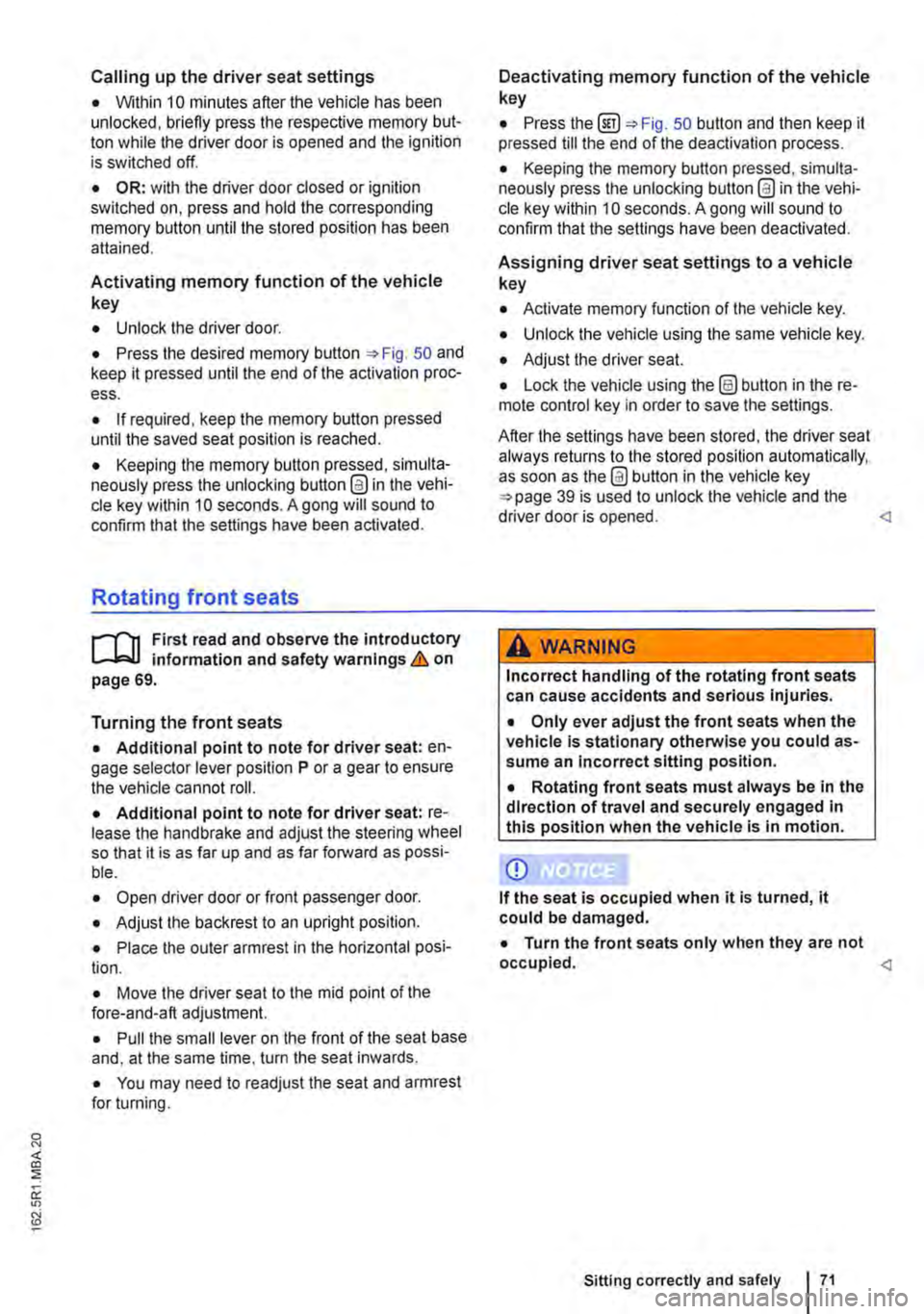
Calling up the driver seat settings
• Within 10 minutes after the vehicle has been unlocked, briefly press the respective memory but-ton while the driver door is opened and the ignition is switched off.
• OR: with the driver door closed or ignition switched on, press and hold the corresponding memory button until the stored position has been attained.
Activating memory function of the vehicle key
• Unlock the driver door.
• Press the desired memory button 50 and keep it pressed until the end of the activation proc-ess.
• If required, keep the memory button pressed until the saved seat position is reached.
• Keeping the memory button pressed, simulta-neously press the unlocking button@ in the vehi-cle key within 10 seconds. A gong will sound to confirm that the settings have been activated.
Rotating front seats
r--('n First read and observe the introductory information and safety warnings & on page 69.
Turning the front seats
• Additional point to note for driver seat: en-gage selector lever position P or a gear to ensure the vehicle cannot roll.
• Additional point to note for driver seat: re-lease the handbrake and adjust the steering wheel so that it is as far up and as far forward as possi-ble.
• Open driver door or front passenger door.
• Adjust the backrest to an upright position.
• Place the outer armrest in the horizontal posi-tion.
• Move the driver seat to the mid point of the fore-and-aft adjustment.
• Pull the small lever on the front of the seat base and, at the same time, turn the seat inwards.
• You may need to readjust the seat and armrest for turning.
Deactivating memory function of the vehicle key
• Press Fig. 50 button and then keep it pressed till the end of the deactivation process.
• Keeping the memory button pressed, simulta-neously press the unlocking button @ in the vehi-cle key within 10 seconds. A gong will sound to confirm that the settings have been deactivated.
Assigning driver seat settings to a vehicle key
• Activate memory function of the vehicle key.
• Unlock the vehicle using the same vehicle key.
• Adjust the driver seat.
• Lock the vehicle using the @button in the re-mote control key in order to save the settings.
After the settings have been stored, the driver seat always returns to the stored position automatically, as soon as the@ button in the vehicle key 39 is used to unlock the vehicle and the driver door is opened. <1
A WARNING
Incorrect handling of the rotating front seats can cause accidents and serious Injuries.
• Only ever adjust the front seats when the vehicle is stationary otherwise you could as-sume an incorrect sitting position.
• Rotating front seats must always be in the direction of travel and securely engaged in this position when the vehicle is in motion.
CD
If the seat is occupied when it is turned, it could be damaged.
• Turn the front seats only when they are not occupied.
Page 72 of 486
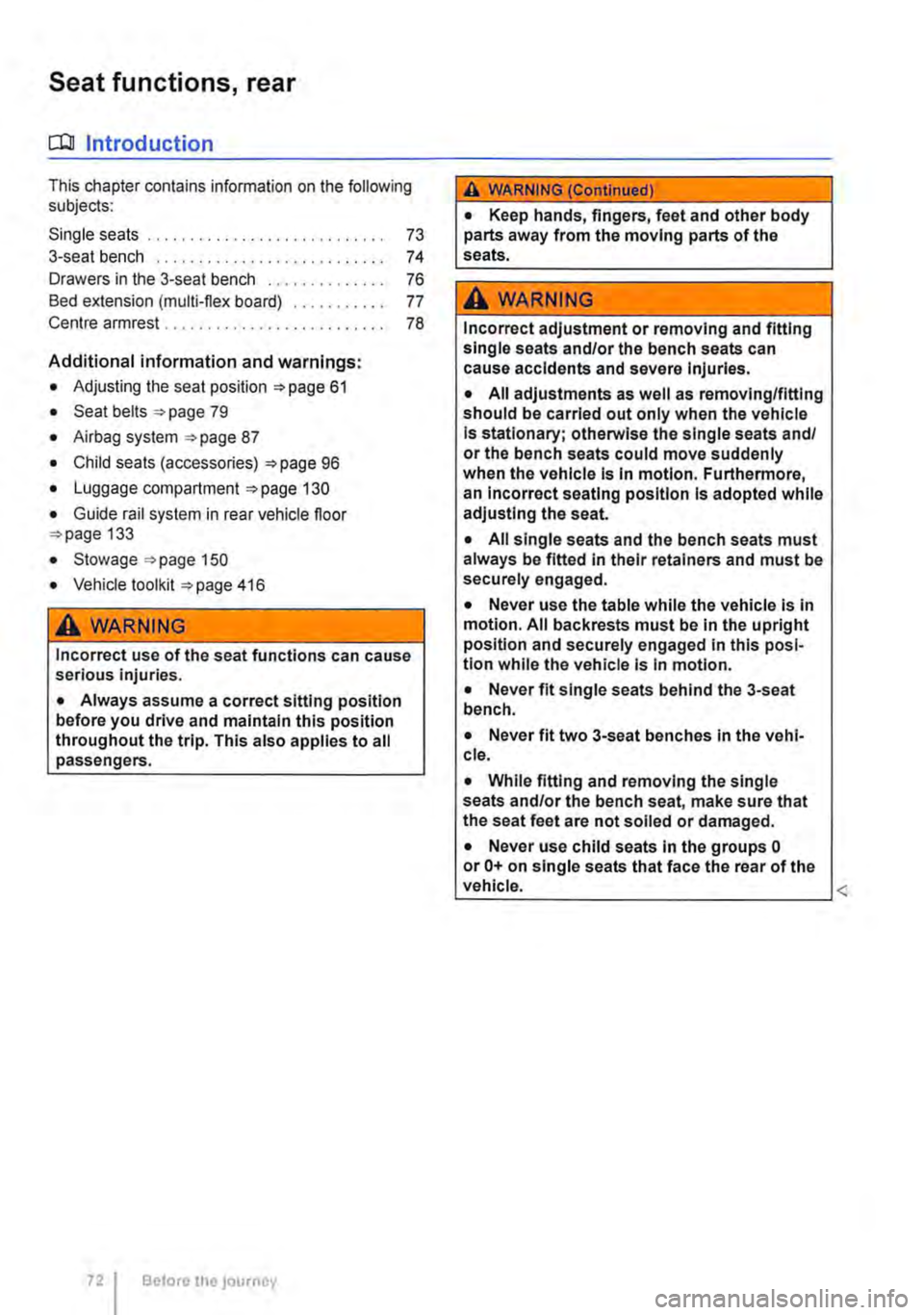
Seat functions, rear
Cl:lJ Introduction
This chapter contains information on the following subjects:
Single seats .
3-seat bench
Drawers in the 3-seat bench ......•.....
Bed extension (multi-flex board) ... Centre armrest ......................... .
Additional information and warnings:
• Adjusting the seat position 61
• Seat belts ""page 79
• Airbag system 87
• Child seats (accessories) :;.page 96
• Luggage compartment :;. page 130
• Guide rail system in rear vehicle floor :;.page 133
• Stowage ""page 150
• Vehicle tool kit ""page 416
A WARNING
73
74
76
77 78
Incorrect use of the seat functions can cause serious injuries.
• Always assume a correct sitting position before you drive and maintain this position throughout the trip. This also applies to all passengers.
721 Before the journey
A WARNING (Continued)
• Keep hands, fingers, feet and other body parts away from the moving parts of the seats.
A WARNING
Incorrect adjustment or removing and fitting single seats and/or the bench seats can cause accidents and severe Injuries.
• All adjustments as well as removing/fitting should be carried out only when the vehicle is stationary; otherwise the single seats and/ or the bench seats could move suddenly when the vehicle Is In motion. Furthermore, an Incorrect seating position Is adopted while adjusting the seat.
• All single seats and the bench seats must always be fitted In their retainers and must be securely engaged.
• Never use the table while the vehicle is In motion. All backrests must be In the upright position and securely engaged in this posi-tion while the vehicle Is In motion.
• Never fit single seats behind the 3-seat bench.
• Never fit two 3-seat benches In the vehi-cle.
• While fitting and removing the single seats and/or the bench seat, make sure that the seat feet are not soiled or damaged.
• Never use child seats In the groups 0 or 0+ on single seats that face the rear of the vehicle. <
Page 73 of 486
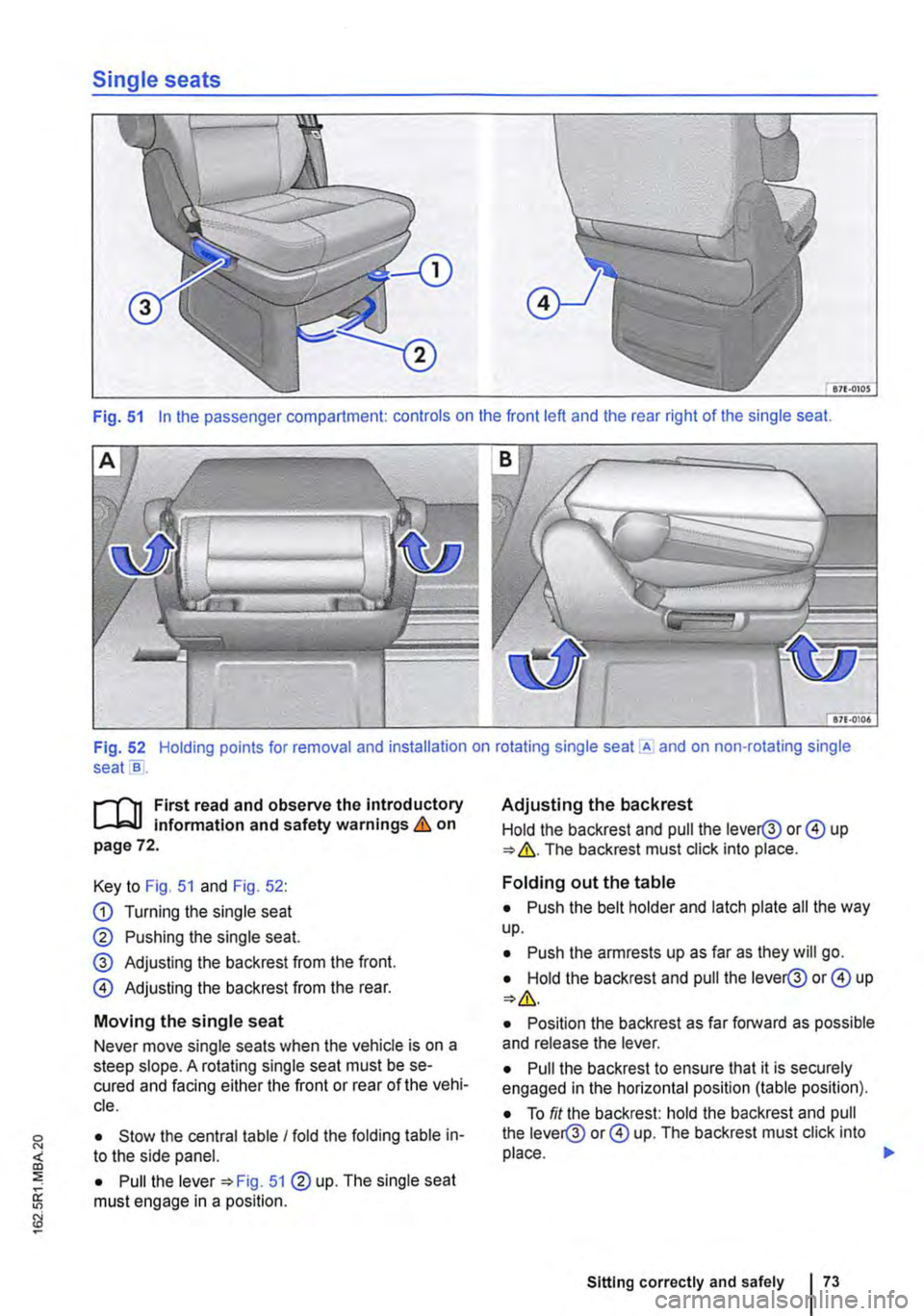
Single seats
Fig. 51 In the passenger compartment: controls on the front left and the rear right of the single seat.
Fig. 52 Holding points for removal and installation on rotating single seat .A and on non-rotating single seats .
....-m First read and observe the introductory L.-.lo:.U Information and safety warnings & on page 72.
Key to Fig. 51 and Fig. 52:
CD Turning the single seat
@ Pushing the single seat.
@ Adjusting the backrest from the front.
0 Adjusting the backrest from the rear.
Moving the single seat
Never move single seats when the vehicle is on a steep slope. A rotating single seat must be se-cured and facing either the front or rear of the vehi-cle.
• Stow the central table I fold the folding table in-to the side panel.
• Pull the lever 51@ up. The single seat must engage in a position.
Adjusting the backrest
Hold the backrest and pull the lever@ or 0 up ""'&.The backrest must click into place.
Folding out the table
• Push the belt holder and latch plate all the way up.
• Push the armrests up as far as they will go.
• Hold the backrest and pull the lever@ or 0 up
• Position the backrest as far forward as possible and release the lever.
• Pull the backrest to ensure that it is securely engaged in the horizontal position (table position).
• To fit the backrest: hold the backrest and pull the lever@ or 0 up. The backrest must click into place. 11>
Sitting correctly and safely
Page 74 of 486
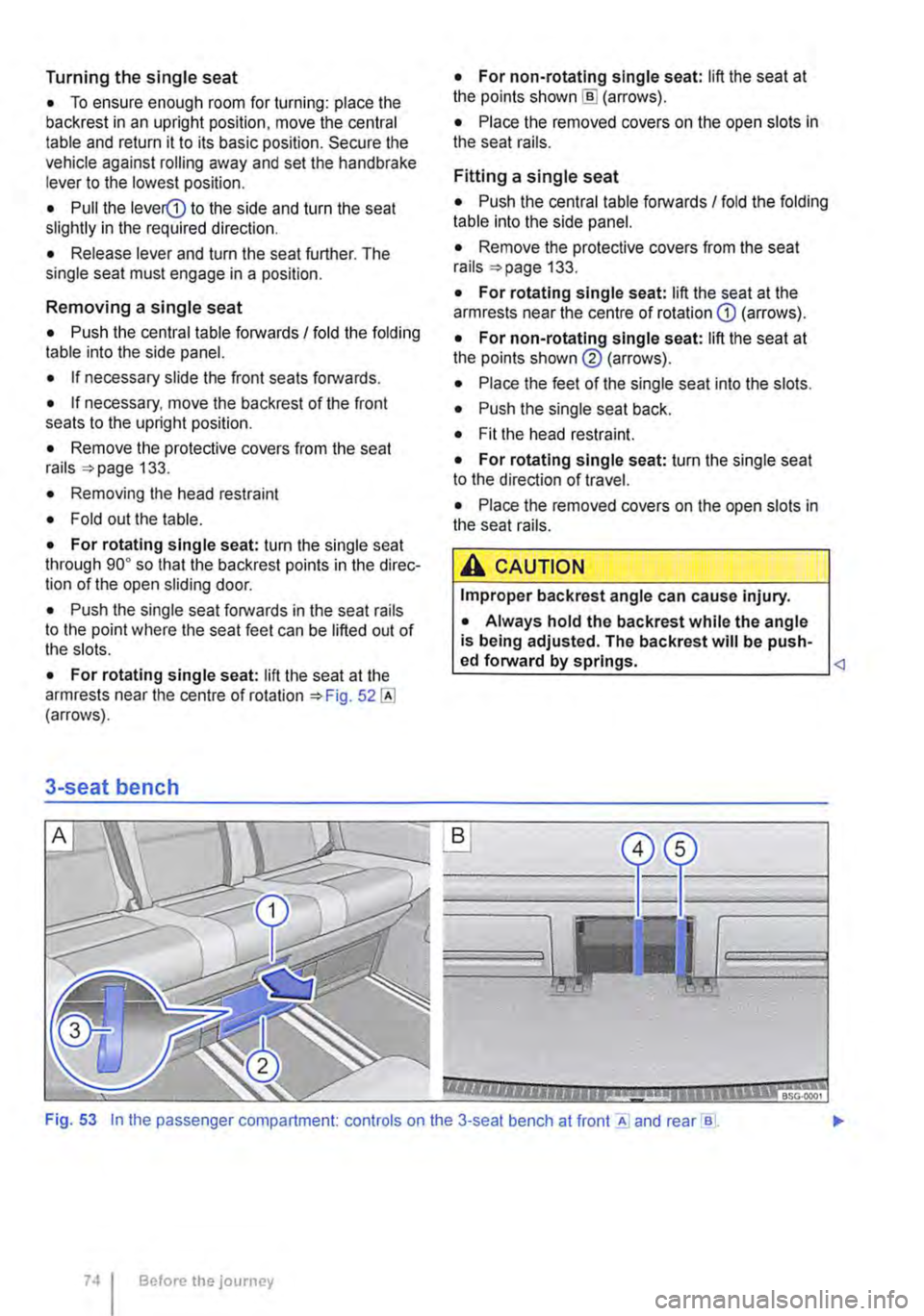
Turning the single seat
• To ensure enough room for turning: place the backrest in an upright position. move the central table and return it to its basic position. Secure the vehicle against rolling away and set the handbrake lever to the lowest position.
• Pull the lever(D to the side and turn the seat slightly in the required direction.
• Release lever and turn the seat further. The single seat must engage in a position.
Removing a single seat
• Push the central table forwards I fold the folding table into the side panel.
• If necessary slide the front seats forwards.
• If necessary, move the backrest of the front seats to the upright position.
• Remove the protective covers from the seat rails 133.
• Removing the head restraint
• Fold out the table.
• For rotating single seat: turn the single seat through go• so that the backrest points in the direc-tion of the open sliding door.
• Push the single seat forwards in the seat rails to the point where the seat feet can be lifted out of the slots.
• For rotating single seat: lift the seat at the armrests near the centre of rotation (arrows).
3-seat bench
• For non-rotating single seat: lift the seat at the points shown [ID (arrows).
• Place the removed covers on the open slots in the seat rails.
Fitting a single seat
• Push the central table forwards I fold the folding table into the side panel.
• Remove the protective covers from the seat rails 133.
• For rotating single seat: lift the seat at the armrests near the centre of rotation G) (arrows).
• For non-rotating single seat: lift the seat at the points shown@ (arrows).
• Place the feet of the single seat into the slots.
• Push the single seat back.
• Fit the head restraint.
• For rotating single seat: turn the single seat to the direction of travel.
• Place the removed covers on the open slots in the seat rails.
A CAUTION
Improper backrest angle can cause injury.
• Always hold the backrest while the angle is being adjusted. The backrest will be push-ed forward by springs.
Before the journey
Page 75 of 486
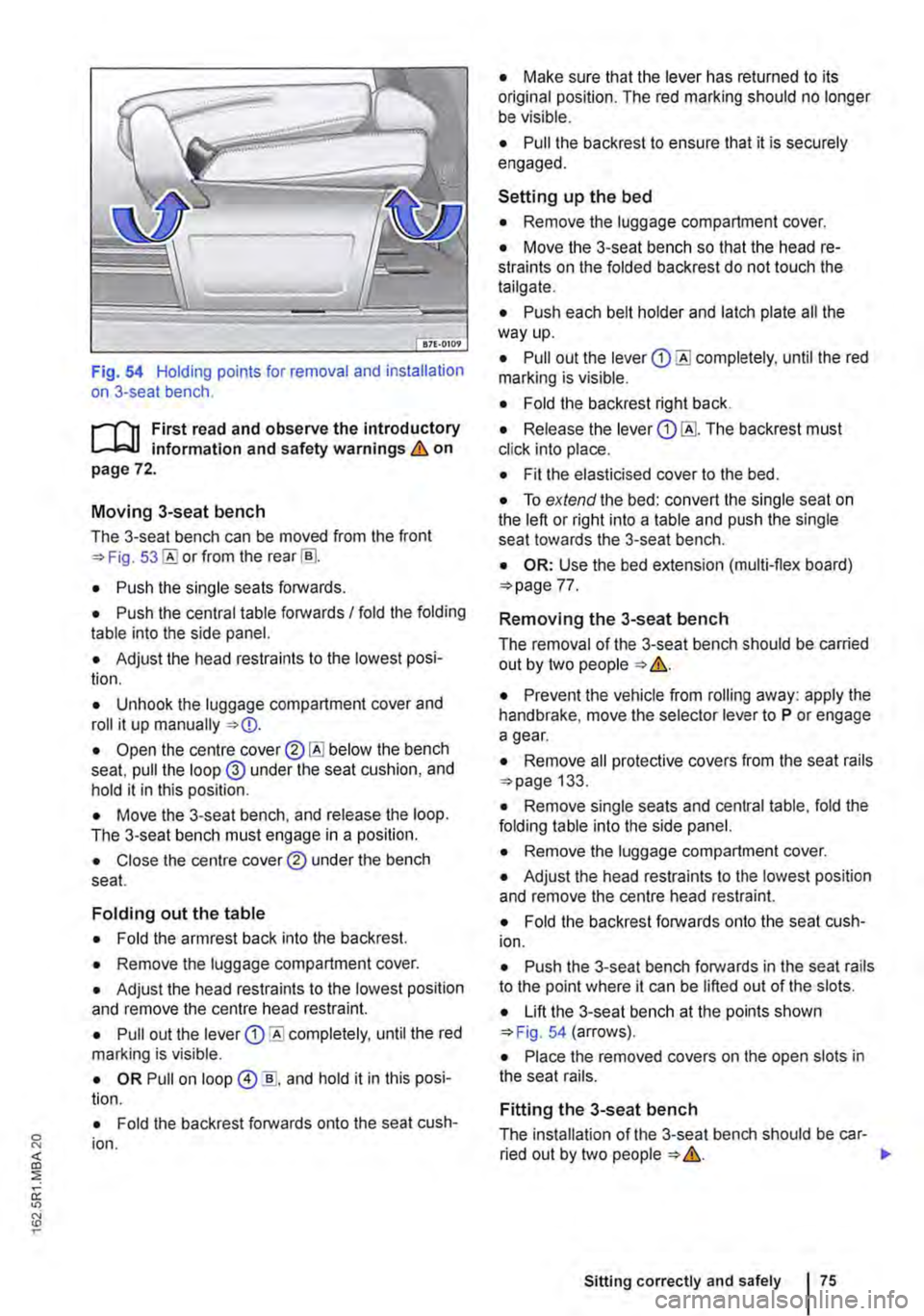
Fig. 54 Holding points for removal and installation on 3-seat bench.
,....-m First read and observe the introductory L-W.I information and safety warnings & on page 72.
Moving 3-seat bench
The 3-seat bench can be moved from the front =>Fig. or from the rear [ru.
• Push the single seats forwards.
• Push the central table forwards I fold the folding table into the side panel.
• Adjust the head restraints to the lowest posi-tion.
• Unhook the luggage compartment cover and roll it up manually =>
• Move the 3-seat bench, and release the loop. The 3-seat bench must engage in a position.
• Close the centre cover® under the bench seat.
Folding out the table
• Fold the armrest back into the backrest.
• Remove the luggage compartment cover.
• Adjust the head restraints to the lowest position and remove the centre head restraint.
• Pull out the lever Q) completely, until the red marking is visible.
• OR Pull on loop @ ]], and hold it in this posi· lion.
• Fold the backrest forwards onto the seat cush· ion.
• Make sure that the lever has returned to its original position. The red marking should no longer be visible.
• Pull the backrest to ensure that it is securely engaged.
Setting up the bed
• Remove the luggage compartment cover.
• Move the 3-seat bench so that the head re· straints on the folded backrest do not touch the tailgate.
• Push each belt holder and latch plate all the way up.
• Pull out the lever Q) until the red marking is visible.
• Fold the backrest right back.
• Release the lever Q) The backrest must click into place.
• Fit the elasticised cover to the bed.
• To extend the bed: convert the single seat on the left or right into a table and push the single seat towards the 3-seat bench.
• OR: Use the bed extension (multi-flex board) =>page 77.
Removing the 3-seat bench
The removal of the 3-seat bench should be carried out by two people => &.
• Prevent the vehicle from rolling away: apply the handbrake, move the selector lever to P or engage a gear.
• Remove all protective covers from the seat rails =>page 133.
• Remove single seats and central table, fold the folding table into the side panel.
• Remove the luggage compartment cover.
• Adjust the head restraints to the lowest position and remove the centre head restraint.
• Fold the backrest forwards onto the seat cush-ion.
• Push the 3-seat bench forwards in the seat rails to the point where it can be lifted out of the slots.
• Lift the 3-seat bench at the points shown =>Fig. 54 (arrows).
• Place the removed covers on the open slots in the seat rails.
Fitting the 3-seat bench
The installation of the 3-seat bench should be car-ried out by two people => &. .,.
Sitting correctly and safely
Page 76 of 486
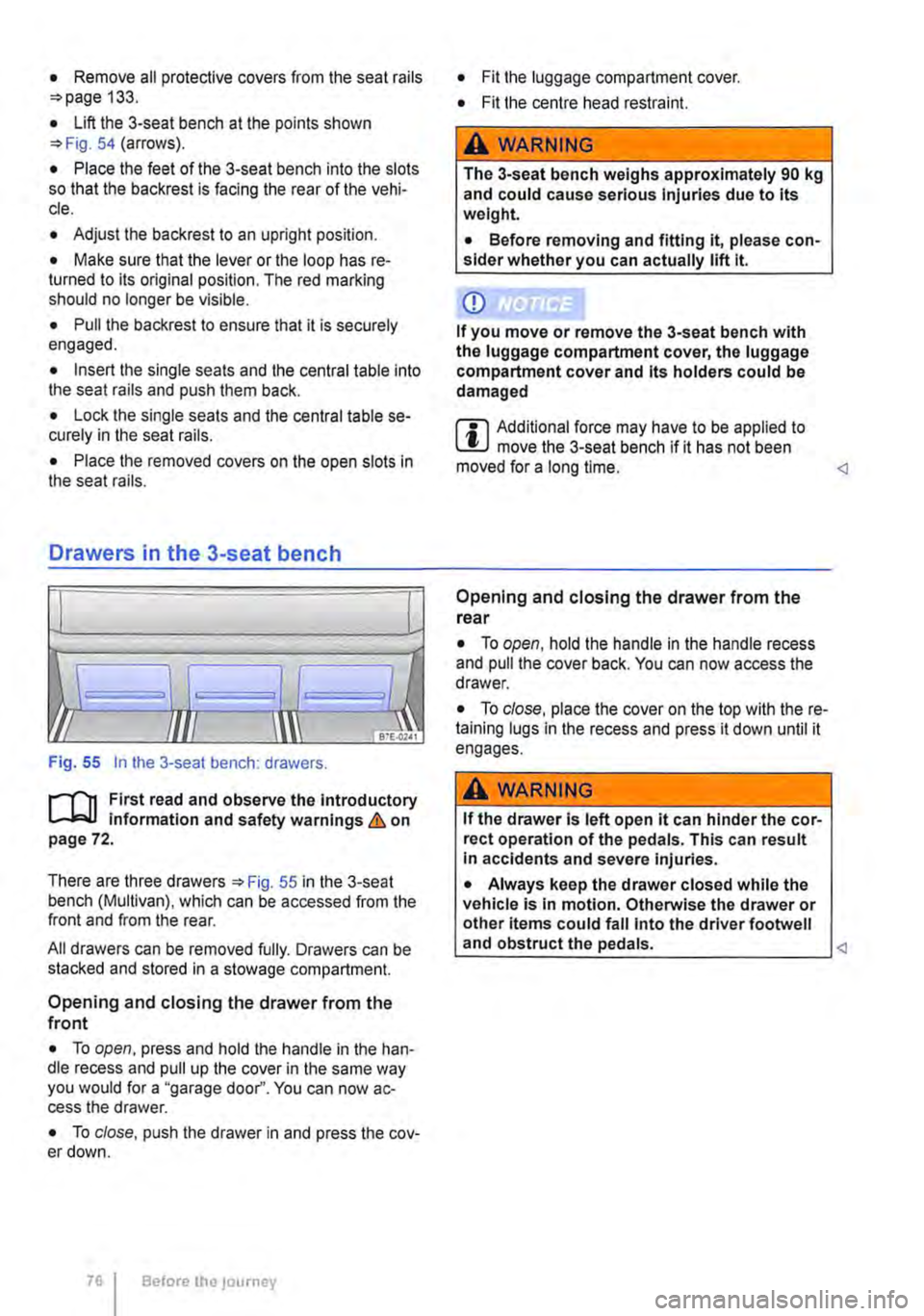
• Remove all protective covers from the seat rails =-page 133.
• Lift the 3-seat bench at the points shown =>Fig. 54 (arrows).
• Place the feet of the 3-seat bench into the slots so that the backrest is facing the rear of the vehi-cle.
• Adjust the backrest to an upright position.
• Make sure that the lever or the loop has re-turned to its original position. The red marking should no longer be visible.
• Pull the backrest to ensure that it is securely engaged.
• Insert the single seats and the central table into the seat rails and push them back.
• Lock the single seats and the central table se-curely in the seat rails.
• Place the removed covers on the open slots in the seat rails.
Drawers in the 3-seat bench
r' ,f} I
---
VII f/l/ \\\
Fig. 55 In the 3-seat bench: drawers.
1""111 First read and observe the Introductory L-lo:oJJ information and safety warnings & on page 72.
There are three drawers =-Fig. 55 in the 3-seat bench (Multivan), which can be accessed from the front and from the rear.
All drawers can be removed fully. Drawers can be stacked and stored in a stowage compartment.
Opening and closing the drawer from the front
• To open, press and hold the handle in the han-dle recess and pull up the cover in the same way you would for a "garage door". You can now ac-cess the drawer.
• To close, push the drawer in and press the cov-er down.
76 Before the journey
• Fit the luggage compartment cover.
• Fit the centre head restraint.
A wARNING
The 3-seat bench weighs approximately 90 kg and could cause serious Injuries due to its weight.
• Before removing and fitting it, please con-sider whether you can actually lift it.
CD
If you move or remove the 3-seat bench with the luggage compartment cover, the luggage compartment cover and Its holders could be damaged
m Additional force may have to be applied to W move the 3-seat bench if it has not been moved for a long lime.
• To open, hold the handle in the handle recess and pull the cover back. You can now access the drawer.
• To close, place the cover on the top with the re-taining lugs in the recess and press it down until it engages.
A WARNING
If the drawer Is left open it can hinder the cor-rect operation of the pedals. This can result In accidents and severe Injuries.
• Always keep the drawer closed while the vehicle is in motion. Otherwise the drawer or other items could fall Into the driver footwell and obstruct the pedals.
Page 77 of 486
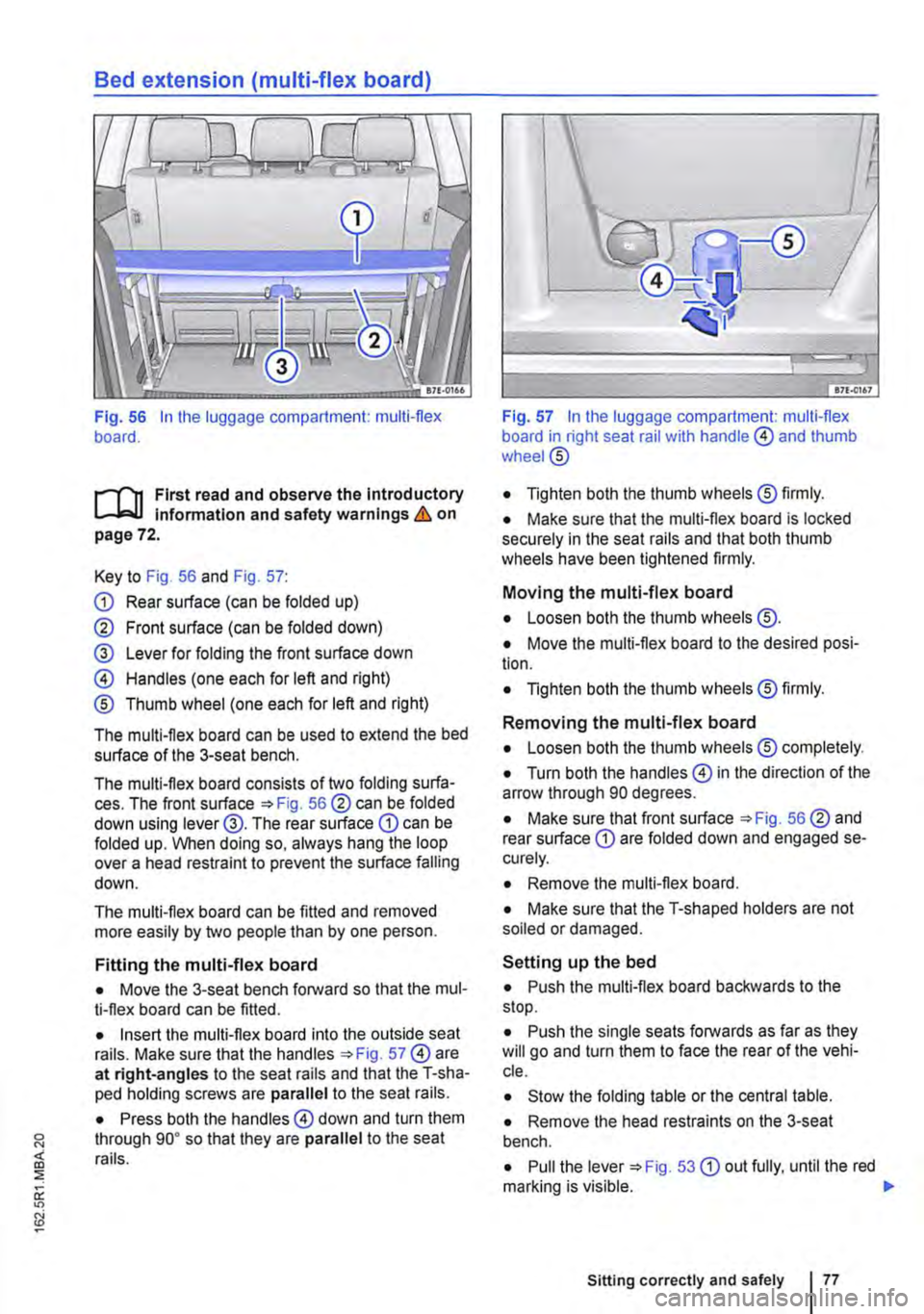
Bed extension (multi-flex board)
Fig. 56 In the luggage compartment: multi-flex board.
.--m First read and observe the Introductory L-.J,..U lnfonmatlon and safety warnings & on page 72.
Key to Fig. 56 and Fig. 57:
CD Rear surface (can be folded up)
@ Front surface (can be folded down)
@ Lever for folding the front surface down
@ Handles (one each for left and right)
® Thumb wheel (one each for left and right)
The multi-flex board can be used to extend the bed surface of the 3-seat bench.
The multi-flex board consists of two folding surfa-ces. The front surface =>Fig. 56@ can be folded down using lever@. The rear surface CD can be folded up. When doing so, always hang the loop over a head restraint to prevent the surface falling down.
The multi-flex board can be fitted and removed more easily by two people than by one person.
Fitting the multi-flex board
• Move the 3-seat bench forward so that the mul-ti-flex board can be fitted.
• Insert the multi-flex board into the outside seat rails. Make sure that the handles =>Fig. 57@ are at right-angles to the seat rails and that the T-sha-ped holding screws are parallel to the seat rails.
• Press both the handles@ down and turn them through go• so that they are parallel to the seat rails.
Fig. 57 In the luggage compartment: multi-flex board in right seat rail with handle @ and thumb wheel@
• Tighten both the thumb wheels® firmly.
• Make sure that the multi-flex board is locked securely in the seat rails and that both thumb wheels have been tightened firmly.
Moving the multi-flex board
• Loosen both the thumb wheels @.
• Move the multi-flex board to the desired posi-tion.
• Tighten both the thumb wheels® firmly.
Removing the multi-flex board
• Loosen both the thumb wheels® completely.
• Turn both the handles@ in the direction of the arrow through 90 degrees.
• Make sure that front surface =>Fig. 56@ and rear surface CD are folded down and engaged se-curely.
• Remove the multi-flex board.
• Make sure that the T-shaped holders are not soiled or damaged.
Setting up the bed
• Push the multi-flex board backwards to the stop.
• Push the single seats forwards as far as they will go and turn them to face the rear of the vehi-cle.
• Stow the folding table or the central table.
• Remove the head restraints on the 3-seat bench.
• Pull the lever =>Fig. 53 CD out fully, until the red marking is visible. 11>
Sitting correctly and safely